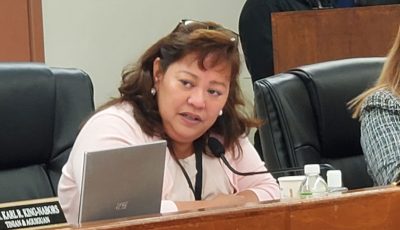ON CUC, 13 CW WORKERS’ MOTION OVER CW-1 RENEWAL INACTION
Sirok: Judge’s ruling likely will cover CW-1 2017 cap
If the federal court issues a ruling on a motion for preliminary injunction that is favorable to the Commonwealth Utilities Corp. and its 13 affected CNMI-only transitional workers (CW-1), it would probably apply for the recently announced Fiscal Year 2017 CW-1 cap, according to CUC legal counsel James S. Sirok.
U.S. District Court for the NMI Chief Judge Ramona V. Manglona heard plaintiffs CUC’s and its 13 affected workers’ motion for preliminary injunction last Friday. Manglona placed the matter under advisement.
At the hearing, Sirok called to the witness stand CUC power plant operations manager Victor Flores. Office of Immigration assistant director Glenn M. Girdharry, counsel for defendant Department of Homeland Security Secretary Jeh Johnson and co-defendants, called to the witness stand U.S. Citizenship and Immigration Services District 26 Director David G. Gulick.
In an interview after the hearing, Sirok said they requested the court to enjoin DHS and the USCIS from enforcing the FY 2016 CW-1 cap.
“I know we are close to the end of the fiscal year, but if the court finds based on my argument that Fiscal Year 2016 cap should be enjoined, that probably would also apply for Fiscal Year 2017 cap that was just announced,” Sirok said. “So that’s under consideration for the court.”
The Fiscal Year 2017 CW-1 cap is 12,998, which is one less than the FY 2016 cap.
Sirok said they asked for injunction based on their arguments that the implementation of those cap numbers were not done in accordance with various provisions of the Administrative Procedure Act.
Sirok said the federal court’s ruling would affect other CW-1 workers in the CNMI because CUC and its 13 foreign workers were not asking for reliefs specific to the plaintiffs or CUC individually, but it’s based on attacking the cap itself and how that number was implemented.
The CUC legal counsel also reiterated that CUC indeed entered a confidential settlement deal with DHS for nine of the 13 affected CW-1 workers.
Sirok said because of the deal, the nine CW-1 workers are still working for CUC, while the four others already left last June at the expiration of their contract.
He said the four workers will come back if their CW-1 petitions are approved.
Sirok said CUC has to petition again for the nine workers and that he does not know the process if they should exit the CNMI if their petitions are approved.
In his declaration, Gulick admitted that DHS did not follow then-governor Eloy S. Inos’ advice to reduce the previous year’s CW-1 permits by a nominal one or to 13,998 for FY 2016 cap. Nonetheless, Gulick said Inos’ views were considered in good faith in DHS’ decision on the FY 2016 CW-1 cap of 12,999.
Girdharry asserted in defendants’ opposition to the motion that the federal court has no jurisdiction over the lawsuit. He said the Administrative Procedure Act expressly precludes judicial review of DHS’ administration of the CW-1 visa cap because it is an agency action committed to agency discretion by law.
Girdharry said the reasonable methodology and criteria that DHS uses to administer the CW-1 visa cap—aimed at achieving the statutory goals of reducing the number of CW-1 workers annually to zero by Dec. 31, 2019, and preventing any adverse effect on the wages and working conditions of domestic workers—is an action that is wholly “committed to agency discretion by law.”
Plaintiffs are suing Johnson and others for not acting on their CW-1 permit renewals.
Aside from Johnson, plaintiffs are also suing U.S. Immigration and Customs Enforcement Director Sarah R. Saldana, and U.S. Citizenship and Immigration Services Director Leon Rodriguez.
Sirok alleged that the failure of USCIS to make a determination on the CW renewal petitions violates the Administrative Procedure Act.
Sirok said CUC will be adversely affected by the loss of these CW-1 workers in its ability to maintain and operate its power generation facilities on Saipan, Tinian, and Rota.
CUC employs over 300 workers, including 42 nonresident workers.



























